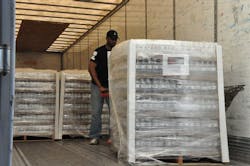The most recent World Economic Outlook issued by the International Monetary Fund (IMF) indicates that “an already sluggish global recovery shows signs of further weakness,” mainly because of continuing financial problems in Europe, fiscal gridlock in the U.S. and slower-than-expected growth in emerging economies.
Consequently, freight volumes are expected to decrease as well – a concern highlighted by Wall Street investment firm Robert W. Baird & Co. in its most recent Freight Flows brief.
“The near-term outlook for freight trends has become increasingly uncertain,” noted Benjamin J. Hartford, one of Baird’s transportation analysts. “[While] we expect second quarter results among many publically traded domestic transport companies to be solid given the support of positive industry growth and falling fuel prices, we expect third quarter outlooks to be muted given: a weaker-than-expected June; seasonally weak freight trends in July/August; and building economic uncertainty.”
On that last point, Olivier Blanchard, the IMF’s chief economist, noted that the firm’s latest WEO now projects that the global economy will grow 3.5% this year, down 0.1 percentage points from the April forecast, and 3.9% in 2013, 0.2 percentage points lower.
The IMF also expressed concern that economic growth in the U.S. could stall because of excessive fiscal tightening caused in its words by “political gridlock.”
“In the extreme, if policymakers fail to reach consensus on extending some temporary tax cuts and reversing deep automatic spending cuts, the U.S. economy could face a steep decline of more than 4% percent of GDP [gross domestic product] in its fiscal deficit in 2013,” noted Blanchard in published remarks.
That so-called “fiscal cliff” would cause a severe decline in U.S. growth, with significant spillovers to the rest of the world, he said – adding that if the U.S. does not act promptly to raise its federal debt ceiling, there will be increased risk of financial market disruption and loss in consumer and business confidence.
Blanchard also pointed out that economic growth has slowed in a number of major emerging economies, especially Brazil, China, and India. This was due both to a weaker external environment and a sharp deceleration in domestic demand in response to capacity constraints and policy tightening, he explained.
In the near term for trucking freight in the U.S., Baird’s Hartford noted that TL demand softened by the end of the second quarter, with June’s month-end TL volume below expectations and that “softness” in volume continuing into July.
LTL trends, by contrast, were more “solid” through June, Hartford said, with private LTL carriers noting that pricing momentum in the sector continued through the second quarter. “[But] we expect LTL rate growth to decelerate in the second half of 2012 into more difficult comparisons, though LTL rate growth should remain above TL contractual rate growth.”
As a result of this “deceleration” in freight volumes, typical capacity tightness became more muted by the end of June, Hartford noted. “We believe slowing truckload volume growth and available capacity will pressure contractual rate growth in the second half of 2012 toward the bottom end of our 2% to 4% year-over-year expectation [for rate increases].”
Baird also expects LTL rate growth to decelerate in the second half of this year, though Hartford stressed the strongest earnings reports in the second quarter should come from LTLs, given the solid LTL pricing momentum and firm demand trends that occurred through the end of June.
However, despite expected solid second quarter results, he said Baird expects recent weakness in trucking volumes and seasonally weak July/August trends forge more “guarded” near-term outlooks among trucking carriers.
About the Author
Sean Kilcarr
Editor in Chief
Sean Kilcarr is a former longtime FleetOwner senior editor who wrote for the publication from 2000 to 2018. He served as editor-in-chief from 2017 to 2018.
